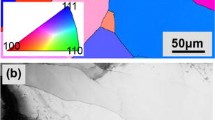Titanium alloys have been used in demanding applications such as the chemical industry and aerospace, thanks to their excellent corrosion resistance, low density, and high-mechanical strength. There have been many research activities recently on titanium alloys, mainly focusing on experiments. The kinetics of phase transformations and the relationship between the microstructure and the final mechanical properties has not been widely studied by computer modeling. In this work, a comprehensive finite-element model coupled with thermodynamic calculations has been developed to simulate the microstructure evolution and predict the final mechanical properties resulting from solidification and \(\upbeta\) to \(\upalpha\) solid phase transformation. This model can be applied to casting and heat treatment processes. The predictions are validated by comparison with experimental measurements. The results show that this model can accurately predict the microstructure, volume fraction of different phases, and the final yield strength of titanium alloys.









Similar content being viewed by others
References
J. Guo and M. Samonds, Properties Prediction with Coupled Macro-Micromodeling and Computational Thermodynamics, Modeling of Casting & Solidification Processes 2004, Hwang Weng-Sing, Ed., Aug 8-11, Metal Industries Research and Development Centre, Kaohsiung, Taiwan, 2004, p157–164
Katzarov I., Malinov S., Sha W.(2002) Finite Element Modeling of the Morphology of β to α Phase Transformation in Ti-6 Al-4 V Alloy. Metall. and Mater. Trans. A, 33:1027–1040
Oh J., Lee J.G., Kim N.J., Lee S., Lee E.W. (2004) Effects of Thinckness on Fatigue Properties of Investment Cast Ti-6 Al-4 V Alloy Plates. J. of Mater Sci. 39:587–591
Kalinyuk A.N., Trigub N.P., Zamkov V.N., Ivasishin O.M., Markovsky P.E., Teliovich R.V., Semiatin S.L. (2003) Microstructure, Texture, and Mechanical Properties of Electron-beam Melted Ti-6 Al-4 V. materials Science and Engineering A 346:178–188
Butler C.J., McCartney D.G., Small C.J., Horrocks F.J., Saunders N. (1997) Solidification Microstructures and Calculated Phase Equilibria in the Ti-Al-Mn System. Acta Mater. 45(7):2931–2947
Suzuki H.G., Takakura E., Eylon D. (1999) Hot Strength and Hot Ductility of Titanium Alloys—a Challenge for Continuous Casting Process. Material Science and Engineering A 263: 230–236
Mitchell A. (1998) Melting, Casting and Forging Problems in Titanium Alloys. Materials Science and Engineering A243:257–262
Ouchi C., Fukai H., Hasegawa K. (1999) Microstructural Characteristics and Unique Properties Obtained by Solution Treating or Aging in β-rich α + β Titanium Alloy. Materials Science and Engineering A263:132–136
Tiley J., Searles T., Lee E., Kar S., Banerjee R., Russ J.C., Fraser H.L. (2004) Quantification of Microstructural Features in α/ β Titanium Alloys. Materials Science and Engineering A 372: 191–198
Moustahfid H., Gey N., Humbert M., Philippe M.J. (1995) Study of β−α Phase Transformations of a Ti-64 Sheet Induced from a High-Temperature β State and a High-temperature α + β State. Metall. and Mater. Trans. A, 28: 51–61
Fujii H.(1998) Strengthening of α + β Titanium Alloys by Thermomechanical Processing. Materials Science and Engineering A243: 103–108
Martin P.L. (1998) Effect of Hot Working on the Microstructure of Ti-base Alloys. Materials Science and Engineering A243:25–31
Seshacharyulu T., Medeiros S.C., Frazier W.G., Prasad Y.V.R.K. (2000) Hot Working of Commercial Ti-6 Al-4 V with an Equiaxed α−β Microstructure: Materials Modeling Considerations. Materials Science and Engineering A284:184–194
Nemat-Nasser S., Guo W., Nesterenko V.F., Indrakanti S.S., Gu Y. (2001) Dynamic Response of Conventional and Hot Isostatically Pressed Ti-6 Al-4 V Alloys: Experiments and Modeling. Mechanics of Materials 33: 425–439
Lindemann J., Wagner L. (1999) Microtextural Effects on Mechanical Properties of Duplex Microstructures in (α + β) Titanium Alloys. Materials Science and Engineering A263: 137–141
Inoue H., Fukushima S., Inakazu N. (1992) Transformation Textures in Ti-15 V-3 Cr-3 Sn-3 Al Alloy Sheets. Materials Transactions, JIM 33(2): 129–137
Boehlert C.J.(1999) Microstructure, Creep, and Tensile Behavior of a Ti-12 Al-38 Nb (at.%) Beta+Orthorhombic Alloy. Materials Science and Engineering A267: 82–98
Thevoz P., Desbiolles J.L., Rappaz M. (1989) Modeling of Equiaxed Microstructure Formation in Casting. Metallurgical Tractions A 20:311–322
Rappaz M., Boettinger W.J. (1999) On Dendritic Solidification of Multicomponent Alloys with Unequal Liquid Diffusion Coefficients. Acta Mater. 47(11): 3205–3219
Wang C.Y., Beckermann C. (1993) A Multiphase Solute Diffusion Model for Dendritic Alloy Solidification. Met Trans. A, 24A:2787–2802
Sarreal A., Abbaschian G.J. (1986) The Effect of Solidification Rate on Microsegregation. Met Trans. A 17A: 2063–2073
C. Zener, Theory of Growth of Spherical Precipitates from Solid Solution, J. Appl. Phys., 1949, 20, p 950
P.E. Castillo, “Kinetics of Precipitation Reactions,” Ph.D. thesis, University of Cambridge, 2002
Malinov S., Guo Z., Sha W., Wilson A. (2001) Differential Scanning Calorimetry Study and Computer Modeling of β⇒α Phase Transformation in a Ti-6 Al-4 V Alloy. Metallurgical and Materials Transactions A 32:879–887
Leyens C., Peters M. (2003) Titanium and Titanium Alloys. Wiley-VCH, Weinheim, Germany
Semiatin S.L., Knisley S.L., Fagin P.N., Zhang F., Barker D.R. (2003) Metall. and Mat. Trans. A 34:2377–2386
Hall E.O. (1970) Yield Point Phenomena in Metals and Alloys. Macmillan, London
N. Saunders, X. Li, A. Miodownik, and J. Schille, An Integrated Approach to the Calculation of Materials Properties for Ti-Alloys, Ti-2003: Proc 10thWorld Conference on Titanium, July 13–18, Wiley-VCH, Germany
Acknowledgments
We gratefully acknowledge Dr. Lee Semiatin from the Air Force Research Laboratory, Wright-Patterson Air Force Base, for providing experimental results of the heat treatment of a Ti-6 Al-4 V alloy.
Author information
Authors and Affiliations
Corresponding author
Rights and permissions
About this article
Cite this article
Guo, J., Samonds, M.T. Microstructures and Mechanical Properties Prediction for Ti-Based Alloys. J. of Materi Eng and Perform 16, 680–684 (2007). https://doi.org/10.1007/s11665-007-9099-y
Received:
Revised:
Accepted:
Published:
Issue Date:
DOI: https://doi.org/10.1007/s11665-007-9099-y




